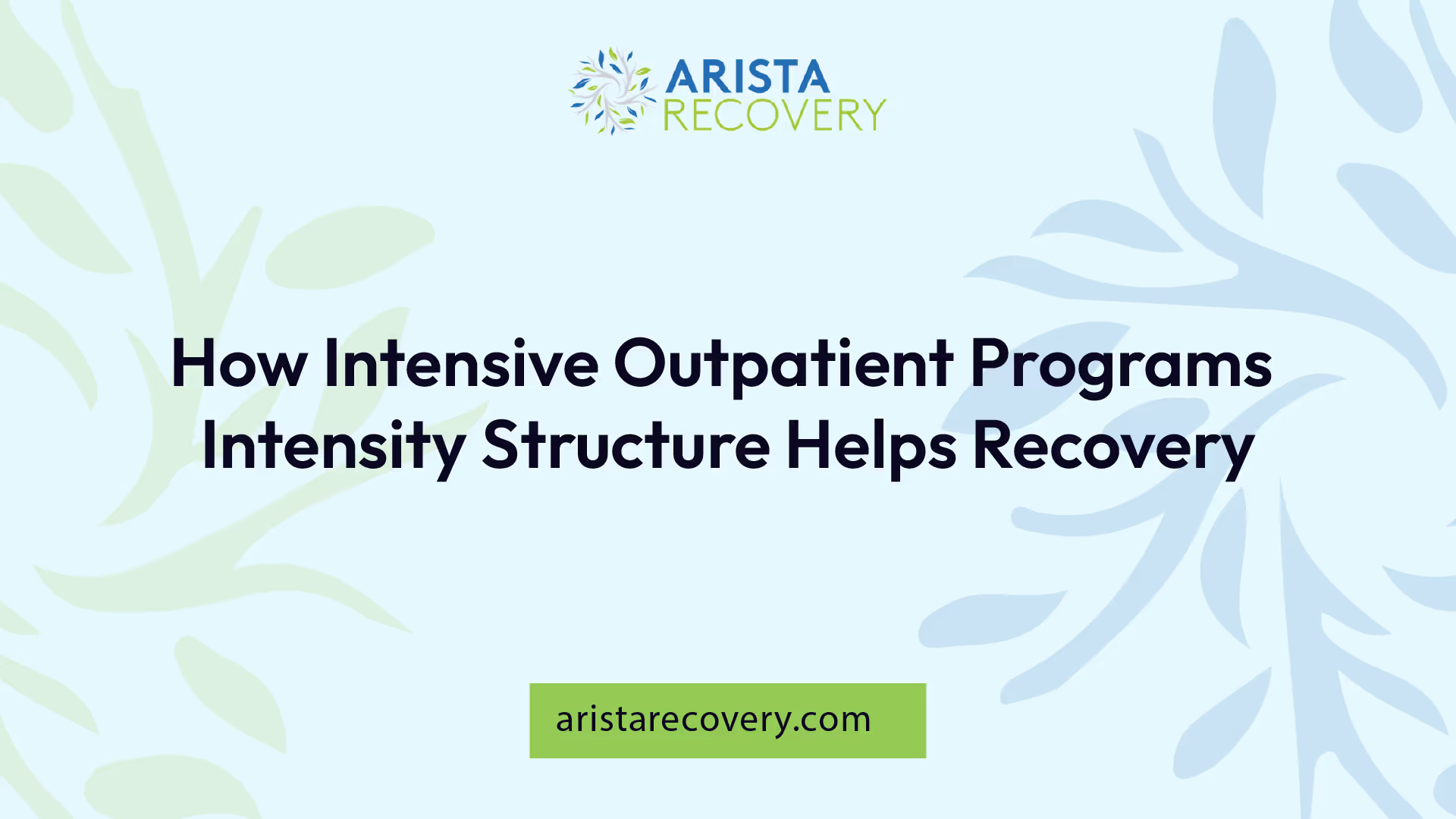How Intensive Outpatient Programs Intensity Structure Helps Recovery

Benefits of Intensive Outpatient Programs
Intensive Outpatient Programs (IOPs) play a critical role in the recovery process for individuals dealing with substance use disorders. Their structured environment and tailored approach to treatment provide significant benefits.

Structure and Purpose
IOPs are designed as a step-down option from more intensive levels of care, such as partial hospitalization or residential treatment programs. They allow individuals to receive a higher level of care while living at home, which enables them to continue engaging in daily commitments including work, school, or family responsibilities.
Typically, treatment entails at least 9 hours per week, often organized into three 3-hour sessions. The therapy may include a mix of individual and group counseling, behavioral therapies, psychoeducation, medication management, and case management services [2]. This structure fosters an environment where individuals can learn and practice recovery skills in real-world settings, emphasizing the practical application of their treatment.
IOP ComponentDetailsWeekly HoursAt least 9 hoursTypical Session Format3 sessions of 3 hours eachTreatment MethodsIndividual counseling, group therapy, medication, behavioral therapies, psychoeducation, case management
Advantages Over Inpatient Treatment
While inpatient programs provide comprehensive support around the clock, IOPs offer a flexible alternative. Research indicates that the treatment services in both inpatient programs and IOPs yield similar outcomes in terms of effectiveness [2].
The main advantage of IOPs is the ability for clients to remain in their everyday environment. This enables individuals to:
The unique structure of IOPs supports recovery while allowing participants to make informed decisions about their treatment journey [3]. Additionally, completing the prescribed treatment regimen within an IOP is crucial for achieving positive outcomes, as premature termination increases the risk of relapse.
The flexibility, structure, and effectiveness of Intensive Outpatient Programs illustrate their significant role in the recovery landscape for individuals confronting addiction.
Key Components of Intensive Outpatient Programs
Intensive Outpatient Programs (IOPs) are designed to provide effective support for individuals recovering from addiction. Focusing on personalized care and treatment, IOPs integrate several essential elements that facilitate healing. Two significant components include therapeutic interventions and individualized treatment plans.
Therapeutic Interventions
IOPs employ a variety of therapeutic interventions aimed at addressing the unique needs of those in recovery. These interventions often include:
These therapies can be conducted in-person or virtually, allowing for flexibility in treatment.
Therapeutic InterventionDescriptionCognitive Behavioral Therapy (CBT)Focuses on changing negative thought patterns.Dialectical Behavior Therapy (DBT)Aims to improve emotional regulation and relationships.Matrix ModelProvides structured support for recovery.12-Step PhilosophiesEncourages community support and accountability.
Individualized Treatment Plans
Individualized treatment plans are a cornerstone of IOP effectiveness. These plans are tailored to meet the specific needs of each participant, taking into account factors such as personality traits, medical history, and personal goals. This tailored approach ensures a more effective and relevant treatment experience.
Programs like those offered at Trinity Behavioral Health integrate evidence-based techniques to create personalized plans. This adaptability is vital for addressing the diverse challenges faced by individuals in recovery, aiding in both mental health treatment and substance abuse goals [5].
Key Features of Individualized Treatment PlansDetailsPersonalizationTreatment is customized to individual needs.Focus on GoalsAddresses both recovery and life goals.Integration of TechniquesUtilizes evidence-based practices for effectiveness.Continuous AdaptationPlans are adjusted based on progress and feedback.
Individualized plans alongside comprehensive therapeutic interventions significantly enhance the recovery experience in Intensive Outpatient Programs.
Effectiveness of Intensive Outpatient Programs
Intensive Outpatient Programs (IOPs) have emerged as a powerful tool in the recovery journey for individuals dealing with addiction. Understanding their effectiveness is essential for grasping how IOPs contribute to healing.
Positive Outcomes
Research indicates that participating in Intensive Outpatient Programs can lead to significant positive outcomes. These outcomes include reduced substance use, improved mental health, and an overall better quality of life. Individuals enrolled in IOPs gain access to a structured environment where they can develop crucial skills and strategies necessary for maintaining sobriety in everyday situations.
Positive OutcomesDescriptionReduced Substance UseActive engagement in therapy can lead to lower rates of substance consumption.Improved Mental HealthParticipants often experience enhanced emotional well-being.Better Quality of LifeOverall life satisfaction increases for those involved in IOPs.
Completion of these programs is crucial. Studies suggest that those who complete their IOP not only have higher chances of maintaining abstinence but also achieve greater long-term recovery compared to those who either leave prematurely or do not participate at all.
Importance of Completion
Completing the full treatment episode in an intensive outpatient setting is vital for achieving positive treatment outcomes. Early termination of these programs can negatively impact recovery, increasing the risk of relapse. According to various studies, regardless of the program's duration, fulfillment of the recommended treatment length correlates with better recovery results. Notably, individuals who actively engage in therapy sessions and adhere to their treatment plans are more likely to attain sustainable recovery [4].
Furthermore, it is often observed that individuals who continue to receive some form of ongoing treatment after completing their IOP fare better than those who do not maintain any post-treatment care. Research shows that those who stay connected to outpatient services for at least two years, or longer, display a greater ability to sustain recovery from addiction [3].
By emphasizing the effectiveness of IOPs and the critical importance of completing these programs, individuals are better positioned to embrace the journey toward lasting recovery.
Tailoring Treatment in IOPs
Intensive Outpatient Programs (IOPs) are designed to provide personalized care, addressing the unique needs of individuals seeking recovery. Two significant aspects of this tailoring process involve dual diagnosis support and modifications for special populations.
Dual Diagnosis Support
IOPs are particularly beneficial for individuals with a dual diagnosis, which involves both substance abuse and co-occurring mental health disorders. These programs deliver a comprehensive approach, ensuring individuals receive the necessary support and treatment for both conditions simultaneously. This dual focus not only enhances recovery outcomes but also promotes holistic healing.
ElementImportance of Dual Diagnosis SupportComprehensive CareAddresses both addiction and mental health in one programIntegrated TreatmentProvides tailored interventions that account for the complexities of dual diagnosisImproved OutcomesIncreases likelihood of successful recovery through cohesive support
Therapeutic strategies employed in IOPs include evidence-based interventions, individual and group therapy sessions, and comprehensive assessments tailored to the client's unique needs. By doing so, IOPs promote healing and growth within a structured, supportive environment.
Modifications for Special Populations
IOPs have successfully adjusted their treatment models to cater to special population groups. This includes adolescents, women with children, and clients from various cultural backgrounds such as Native American and Spanish-speaking individuals. By modifying treatment approaches and providing culturally sensitive care, IOPs can effectively address the unique challenges faced by these populations.
Population GroupSpecific Modifications AddressedAdolescentsYouth-focused therapies and peer supportWomen with ChildrenParenting support services and childcare optionsNative AmericanIntegration of cultural practices and community resourcesSpanish-speakingBilingual staff and culturally relevant materials
Specialized mental health professionals in IOPs utilize these tailored strategies, fostering an inclusive environment where all individuals can thrive. The emphasis on individual needs ensures a more effective recovery journey, catered to the specific circumstances of each participant [5].
Duration and Progression in IOPs
Understanding the duration and progression of Intensive Outpatient Programs (IOPs) is crucial for individuals seeking recovery from substance use disorders. This section details the typical program length and the stages of treatment within IOPs.
Program Length
The duration of intensive outpatient programs can vary based on individual needs and the treatment approach used. Typically, IOPs may last from several weeks to a few months. The length is influenced by factors such as the severity of the addiction, individual progress, and the structure of the program.
Program TypeTypical LengthShort-term IOP4-8 weeksLong-term IOP8-16 weeks
The chronic relapsing nature of substance use disorders means individuals may stay in continuing community care for months or years, transitioning from formal treatment to community-based organizations to maintain gains in abstinence [6].
Stages of Treatment
IOP programs are often designed with a structured approach, conceptualized into two core stages. As clients progress, the intensity of treatment eases, allowing them to assume more responsibility with less supervision from staff.
StageDescriptionStage 1: Intensive TreatmentHigh level of support and engagement, typically involving multiple sessions per week. Focus on establishing coping mechanisms and beginning recovery processes.Stage 2: Transition PhaseReduced intensity and supervision, clients gradually take on more responsibility while integrating skills learned into daily life.
Clients who complete the stages of IOP can step down to outpatient programs and move to maintenance, which builds on initial recovery gains. Continuing community care post-IOP is crucial, particularly for clients with long-term psychiatric, social, or medical issues. This structured progression within IOPs plays a vital role in helping individuals sustain their recovery journey effectively.
Practical Aspects of Intensive Outpatient Programs
Cost and Insurance Coverage
Intensive Outpatient Programs (IOPs) provide comprehensive care that can be more affordable compared to residential treatment centers. The typical cost of an IOP ranges from $3,000 to $10,000, depending on factors such as location, facility type, and included services [4].
Most health insurance plans are likely to cover part or all of the expenses associated with an IOP, provided that the treatment is deemed medically necessary. This accessibility allows a broader range of individuals to seek help for their substance use disorders.
Cost RangeDescription$3,000 - $10,000Typical cost for Intensive Outpatient ProgramsCoverageMost insurance plans cover IOPs if medically necessary
Transitioning to Continuing Care
The transition from Intensive Outpatient Programs to continuing care is crucial for recovery. Clients who maintain their recovery often engage in some form of outpatient treatment for at least two years, with many continuing indefinitely [3]. This extended participation in recovery services is essential for helping individuals sustain sobriety, effectively manage life challenges, and encourage ongoing personal growth.
Completing the full treatment episode in an IOP is vital for positive outcomes. Early termination can lead to a higher risk of relapse. Those who actively engage in therapeutic sessions and adhere to their treatment plans can enhance their likelihood of achieving lasting recovery [4].
Continuing CareImportanceDurationClients typically continue outpatient treatment for at least 2 yearsCompletion of IOPEssential for positive treatment outcomes and long-term recoveryRisk of Early TerminationIncreases risk of relapse if treatment is not completed
The structured approach of IOPs equips individuals with the skills necessary for sustained recovery while still allowing them to maintain their daily responsibilities, making the transition to continuing care a pivotal part of the healing process.
References
[2]:
[3]:
[4]:
[5]:
[6]:
You’re not alone in this.
When mental health challenges and addiction intersect, it can feel isolating. At Arista, we offer compassionate, evidence-based, and trauma-informed care to help you heal, grow, and move forward.
You’re not alone in this.
When mental health challenges and addiction intersect, it can feel isolating. At Arista, we offer compassionate, evidence-based, and trauma-informed care to help you heal, grow, and move forward.
Support that moves with you.
You’ve taken a brave first step. At Arista Recovery, we’re here to help you continue with best-in-class care designed for long-term healing and support.
.webp)






